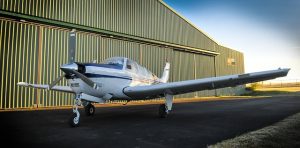
Of all the avionics in a typical airplane’s cockpits, few are as important as a flight management system (FMS). Pilots use it to perform a variety of tasks. What is an FMS exactly?
The Basics of an FMS
An FMS is a computer system that supports a variety of flight-related tasks. Most medium- and large-sized airplanes have a single FMS. It’s typically located between the pilot and the copilot.
One of the first modern FMSs was introduced with the 767. Developed by Boeing in 1981, the 767 is a wide-body airliner. It featured many improvements over its predecessors, including a modern FMS. Since then, FMSs have become an essential avionics component. Nearly all commercial airplanes have an FMS.
Breaking Down the Functions of an FMS
There are many different types of FMSs, some of which have different functions than others. However, they are all designed to assist pilots with various flight-related tasks, one of which is navigation.
Prior to the advent of FMSs, navigators were often required for long-distance flights. Navigators were responsible for identifying landmarks and, ultimately, helping pilots navigate. FMSs eliminated the need for navigators. Modern FMSs feature a navigation database that’s used in the creation of flight plans. The navigation database is updated every 28 days.
There are two types of navigation data:
- Vertical: This is navigation-related data about the airplane’s vertical profile, such as its climb and descent. It’s based on pre-programmed parameters and flight plans.
- Lateral: This is navigation-related data about the airplane’s lateral profile. It essentially controls the airplane’s direction and route.
FMSs typically relay flight plan data to pilots via an electronic display. There are Navigation Displays (NDs), Multifunction Displays (MDs) and other types of electronic displays. Regardless, pilots can monitor the connected display to view their respective flight plans.
Another core function of FMSs is positioning. It identifies the position of the airplane with which it’s used. Most FMSs use one or more sensors for positioning. They work in conjunction with a Global Positioning System (GPS) sensor and/or other types of sensors to determine where the airplane is located.
FMSs can even provide guidance. It uses data from the airplane’s flight plan and position for this purpose. As the airplane’s FMS analyzes this data, it will generate guidance for the pilot.
In Conclusion
It may look like nothing more than a small computer, but an FMS is a powerful avionics system. It supports navigation, flight plans, positioning, guidance and other flight-related tasks.
- SEO Powered Content & PR Distribution. Get Amplified Today.
- PlatoData.Network Vertical Generative Ai. Empower Yourself. Access Here.
- PlatoAiStream. Web3 Intelligence. Knowledge Amplified. Access Here.
- PlatoESG. Carbon, CleanTech, Energy, Environment, Solar, Waste Management. Access Here.
- PlatoHealth. Biotech and Clinical Trials Intelligence. Access Here.
- Source: https://monroeaerospace.com/blog/what-is-a-flight-management-system-fms/
- :is
- :where
- 1981
- 200
- 28
- 300
- a
- About
- advent
- airliner
- Airplane
- Airplanes
- All
- an
- analyzes
- and
- ARE
- AS
- assist
- based
- Basics
- become
- between
- Boeing
- but
- by
- CAN
- climb
- commercial
- component
- computer
- conjunction
- connected
- controls
- copilot
- Core
- creation
- data
- Database
- Days
- designed
- Determine
- developed
- different
- direction
- Display
- displays
- down
- Electronic
- eliminated
- essential
- essentially
- Even
- Every
- exactly
- Feature
- featured
- few
- First
- flight
- Flights
- For
- from
- function
- functions
- generate
- Global
- gps
- guidance
- Have
- helping
- High
- However
- HTTPS
- identifies
- identifying
- important
- improvements
- in
- Including
- introduced
- IT
- ITS
- jpg
- landmarks
- like
- located
- Look
- look like
- management
- management system
- many
- max-width
- May..
- Modern
- Monitor
- more
- most
- Navigate
- Navigation
- nearly
- Need
- nothing
- of
- often
- on
- ONE
- or
- Other
- Others
- over
- parameters
- perform
- pilot
- Pilots
- plan
- plans
- plato
- Plato Data Intelligence
- PlatoData
- position
- positioning
- powerful
- Profile
- provide
- purpose
- Regardless
- required
- respective
- responsible
- Route
- sensors
- since
- single
- small
- some
- such
- Supports
- system
- tasks
- than
- that
- The
- their
- then
- There.
- they
- this
- to
- two
- types
- typical
- typically
- Ultimately
- updated
- use
- used
- uses
- variety
- various
- vertical
- via
- View
- was
- were
- What
- What is
- which
- will
- with
- Work
- zephyrnet












